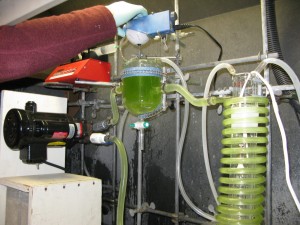As an alternative to biodiesel, Green Mountain Spark (GMS) with the support of the University of Vermont (UVM) Chemistry Department is optimizing a chemical conversion process for the decarboxylation of vegetable oils to generate a new green diesel fuel. The chemical structure of the hydrocarbon fuel products formed from the decarboxylation process is very similar to compounds present in conventional petrodiesel, allowing easy adoption of this fuel (green diesel) into existing infrastructure. Compared to biodiesel, this fuel will have improved fuel storage and transportation properties as well as superior cold weather characteristics.
PROJECT TASKS –The first step the project managers, Sandy Wurthmann and Bryan Holmes took was to modify their existing reactor design and construct the next generation prototype; the GMS photo-reactor II. The addition of new components improved the previous system and allowed for complete conversion to green diesel. Isolating system variables allowed for further experimentation, which included optimization of iron, hydrogen peroxide concentration, flow rate, solvent/feedstock mixing, temperature, and pH. The results were monitored using infrared spectroscopy, mass spectrometry, and nuclear magnetic resonance spectroscopy to confirm the functionality of the photo-reactor. The results of these studies led to further improvements in system performance and consistency
Next, the GMS team optimized their process for extracting oil from algae while it remained in its water media, in comparison to standard dewatering, freeze-drying and hexane extraction. They looked for improved reaction rates by experimenting with a number of variables such as ultra-violet light intensity, flow-rate of feedstock across light exposure area, photo-Fenton reagent concentration, feedstock mixing mode, and temperature. Using canola oil for these early experiments, Green Mountain Spark demonstrated for the first time that their photo-reaction system could successfully convert a common free fatty acid feedstock to green diesel in a single batch.
In their final task, the GMS project managers contracted with outside researchers who used complex systems modeling software to evaluate the life cycle energy balance and cost input of this process. The modeling takes into account all aspects of the green diesel process and distribution, including production and shipping of reagents & feedstocks (e.g. algae oil, canola oil, iron salts, hydrogen peroxide) and the energy costs associated with the distribution of the green diesel fuel.
After reaction of the feedstock in the GMS reactor, green diesel samples were collected and tests were conducted on a suite of biofuels properties, including cloud point, pour point, cold filter plug point, and heat of combustion.
PROJECT OUTCOMES & IMPACTS – This R&D project is helping to address market barriers within the biomass feedstock supply chain. The results from the GMS-1 green diesel biofuel clearly show a strong advantage in its cold flow properties compared to canola biodiesel (methyl ester), canola oil, and diesel #2 (see Table below). The cold filter plugging point is a common test used to compare fuels and their likely ability to plug a fuel filter. GMS-1 has nearly a 20°C (68°F) improvement in the cold weather applicability compared to biodiesel. This endorses the hypothesis that green diesel fuels generated using this conversion process will have a broader market application, especially in northern climates, where these fuels wouldn’t be limited to summer use and/or blending with petrodiesel.
|
Biofuel Type |
Cloud Point (°C/°F) |
Pour Point (°C/°F) |
Cold Filter Plugging Point (°C/°F) |
Heat of Combustion (BTU/lb) |
|
GMS-1 Green Diesel |
-27/-16.6 |
-37/-34.6 |
-22/-7.6 |
18,344 |
|
Canola Biodiesel (Methyl Esters) |
-4/24.8 |
-10.8/12.5 |
3.6/38.5 |
15,500 |
|
Canola Oil |
0/32 |
-9/15.8 |
18/64.4 |
17,100 |
|
Diesel #2 |
-15 to -25/ 5 to -13 |
5 to -25/ 41 to -13 |
-6 to -12/ 21 to 10.4 |
19,300 |
The photochemical conversion process used by Green Mountain Spark also has real economic advantages over biodiesel in three main areas. The first is that photochemical reactors have the potential to be highly scalable. This opens the door for this conversion process to be part of regionally distributed networks, with the photochemical reactors being supplied to farms, energy co-ops, wastewater treatment plants, algae generators and other focused points of renewable oil production. The second economic advantage is that the photochemical reactor is able to convert free fatty acids. This capability paves the way for the potential use of inexpensive non-edible oil feedstocks and FOGs (Fats, Oils & Greases). Finally, the economics of a true drop-in green diesel product with these cold weather capabilities creates a product that would be viable no matter the weather.
The environmental impacts of green diesel, along with the benefits of distributed generation would be 1) real reductions in the greenhouse gas emissions from using a low-carbon fuel and reducing fuel distribution miles, 2) reagents can be generated on-site contrary to methanol and ethanol delivery and 3) broader year-round application would allow for greater reductions in petrodiesel use.





